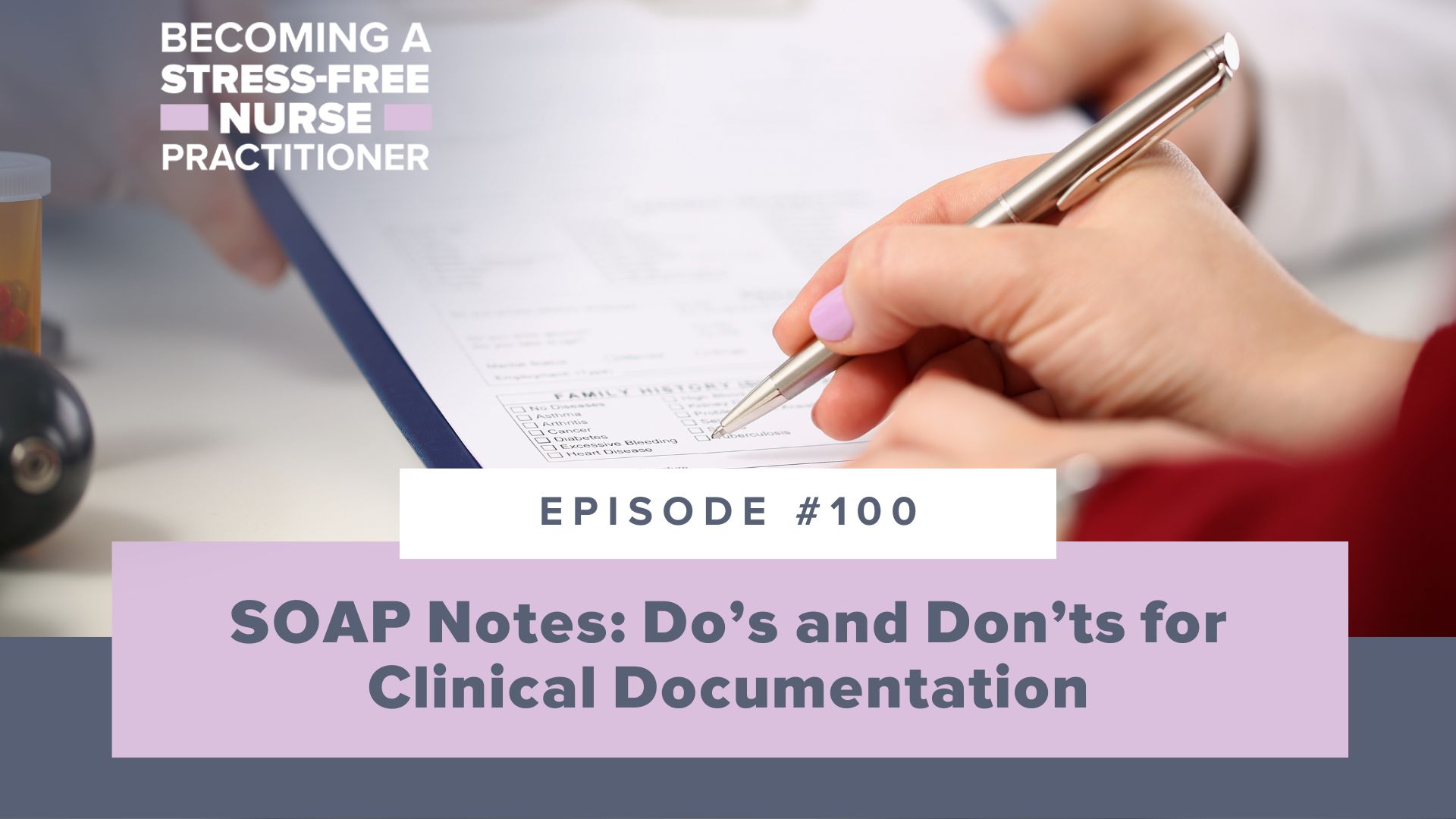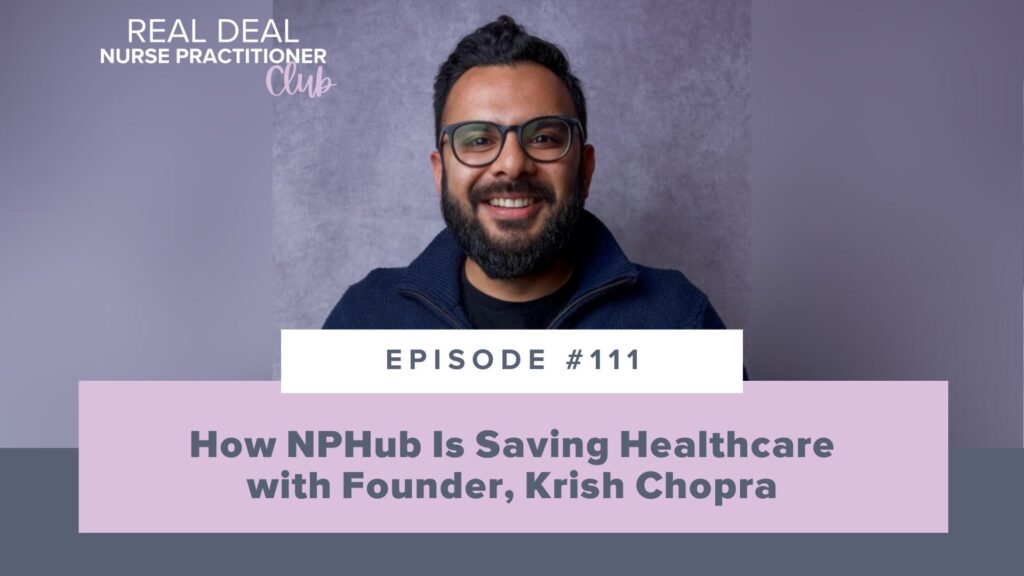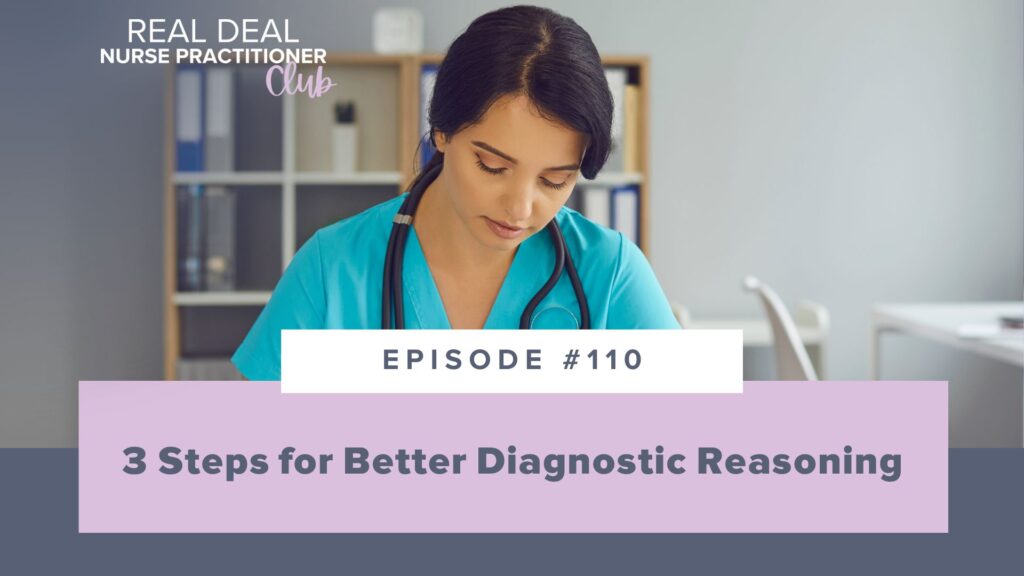Ep #100: Nursing SOAP Notes: Do’s and Don’ts for Clinical Documentation
- by
- Nov 15, 2023
- Podcasts

This week, Anna and I are here to dive into a super important topic all Nurse Practitioners must be skilled at: clinical documentation.
The most common and widely accepted format of clinical documentation is the SOAP note. It addresses the legal aspect of documenting the care you provide, but it also allows for consistency across providers, which is essential in healthcare. With all providers using the same format, it allows anyone reading it to follow along with your patient’s diagnosis and management plan. So how do you use it effectively?
Listen in this week to hear our top do’s and don’ts as they relate to using nursing SOAP notes for clinical documentation. Anna and I are discussing what the SOAP note entails, what to include and avoid in your documentation, and our advice for how to keep refining your clinical documentation skills.
If you’re looking for support, no matter what phase of your nurse practitioner journey you’re currently in, I have communities available for both students and new nurse practitioners. In these communities, we work to uplift one another and grow this profession together every day, so click here to check them out!
What You Will Discover:
- What SOAP note for nurses entails.
- Why the SOAP note serves as a great roadmap for clinical reasoning.
- The value of using the SOAP note format in your clinical documentation.
- Important considerations for what to include and avoid in your clinical documentation.
- Some of the common pitfalls we’ve seen in clinical documentations.
Featured on the Show:
- If you’re looking for extra support, I have communities available for both students and new nurse practitioners. Click here if you’re a student, and click here if you’re a new NP!
- Follow me on: Facebook | Instagram | YouTube | TikTok
Full Episode Transcript:

Welcome to Becoming a Stress-Free Nurse Practitioner, a show for new NPs and students that want to pass their board exam the first time and make that transition from RN to NP as seamless as possible. I’m your host Sarah Michelle. Now, let’s dive into today’s episode.
Sarah: Hey, y’all, today we are talking about a super important topic that providers must be skilled at, and that is clinical documentation. The most common and widely accepted format of clinical documentation is the SOAP note. And I remember when I was first in nurse practitioner school and hearing about SOAP notes, and I was like, that’s a really weird name. But now that we’ve been out in the real world for a few years as real deal nurse practitioners, the SOAP note format is just like second nature to us.
And so in healthcare, consistency and documentation is going to be essential. And that’s not only just for the legal aspect of documenting the care you provide, but also because the SOAP note allows for consistency across providers. With all providers utilizing the same format, it allows anyone reading that SOAP note to be able to follow along with the visit, as well as the provider’s train of thought in diagnosis and management of the patient.
In this episode, we are going to be discussing more about what a SOAP note is, how to write one, and some tips that you can use in your practice. So let’s get started with this episode. Anna, just tell us what are SOAP notes.
Anna: Yeah, so as you just mentioned, that SOAP note is the accepted form of clinical documentation for healthcare providers. And what that acronym stands for is subjective, objective, assessment and plan. And the components, in that order, really do follow how a patient visit unfolds.
So the SOAP note, it not only serves as a documentation format, but it’s a really nice roadmap, I think, for clinical reasoning. And it’s literally all of that in just those four letters. So starting with that S, subjective information. Remember, this is anything that the patient tells us.
And then the O, the objective information is what you, as that real deal NP, gather. So the vital signs, the physical exam, any labs or diagnostic tests. Now, this part gets a little bit confusing in the SOAP note acronym, but assessment is really the diagnosis. And I know this is like a common area of confusion with people still in NP school. Assessment in a SOAP note is not the physical assessment, right? That’s your objective findings. But it’s rather what I think of as the assessment of the situation. So what the diagnosis is.
And then lastly, plan. Very simple, plan is the plan. So that’s where you’re going to list the management plan and any follow-up that’s needed. And we’ll definitely go more into each component in detail coming up.
Sarah: And I think with that in mind, let’s think about how a patient visit goes. Typically the patient offers a chief concern about why they need to be seen that day. And from that, you, the nurse practitioner, are going to ask them questions to better understand the problem.
After asking questions, a physical exam is completed, maybe some diagnostic tests are done. And you’ll start putting that clinical picture together with the history and the physical exam, come up with a diagnosis for the patient, followed by that detailed plan.
And so it sounds a lot like the components of a SOAP note, right? Exactly. So by using the SOAP note format, in documentation, I can ensure that anyone reading that note will understand how that patient visit unfolded, as well as provide a basis for my clinical and diagnostic reasoning. And that is so important for continuity of care among health care providers, as well as a way just to protect yourself legally too.
Anna: Yeah, that continuity of care is so important. So let’s dive a little bit more into each one of these SOAP note components. So I’ll start with the S, the subjective. And remember that subjective section, it is information coming from the patient, or you can think of this as like from the subject.
So subjective information includes that chief concern Sarah just mentioned, or basically that brief statement about why the patient needs to be seen. That is then followed by our history of present illness, often abbreviated to HPI. And I really like to think of that section as painting the picture of how the patient perceives the concern. So during that HPI you’re going to ask the patient questions to qualify the problem.
A really common acronym, I know we use this in our review courses a lot, is old carts. So remember that stands for onset, location, duration, characteristic, alleviating or aggravating factors, radiation or relieving factors, timing and severity. And then after the HPI, that’s when comes what’s called the review of systems.
Now, the review of systems, it is all about just like the pertinent positives and negatives. So it’s just like a brief summary of what symptoms the patient has or does not have.
So, for example, let’s just say we have a patient with an uncomplicated urinary tract infection. In that review of systems, I might document something like positive for dysuria, urgency and frequency, negative for fever and back pain. So those pertinent positives and negatives, they really provide that starting point for our diagnostic reasoning.
Now, Sarah, do you want to tackle the objective section?
Sarah: Yeah, so remember that with the objective section, this is the information that you as the provider are going to gather. This is observable and measurable data. This includes things like vital signs, physical exam, and then any lab or diagnostic data that you gather during the visit, such as lab work you reviewed or maybe you completed a rapid strep test, for example.
In a focused SOAP note, which is for acute visits, you want to aim to include a minimum of three to five body systems in your physical assessment. This is tied to your billing and your coding level, but also will provide enough support for your differential diagnosis. You can easily reach three to five body systems by always including general observations such as the patient is well appearing, well nourished and no acute distress, as well as always including at least a basic cardiac and respiratory exam.
No matter what my patient comes in with, I am always at least listening to their heart and their lungs. And so that is three body systems right there. And then you can assess whatever body system or systems relate to their chief complaint.
If someone is coming in for a chronic disease follow-up or to establish as a new patient, your physical exam will include most, if not all body systems.
And Anna, do you want to talk more about the assessment section?
Anna: Yes, the assessment section, which remember is not the physical assessment, is your diagnosis. But as NPs we’re going to determine the diagnosis based upon that subjective and objective information. And if there is more than one diagnosis, which we know absolutely happens in primary care, then you list them in order of importance.
So, for example, let’s say I diagnosed a patient with pneumonia, but they also have a history of diabetes. I would go ahead and list pneumonia as the primary diagnosis for today, or basically my first diagnosis listed, followed by diabetes.
And you might be asking why I would even include diabetes on my assessment list if the patient has a respiratory issue, and that’s a great question. But keep in mind here that their history of diabetes is relevant to the plan of care, right? I know the acute illness of pneumonia can affect their underlying diabetes, and I might need to adjust my plan of care accordingly.
Now, also in the assessment section, you can and you should, definitely should provide the rationale for your diagnosis. So back to the example I gave a little earlier of an uncomplicated UTI or cystitis, I would write that as my primary diagnosis and then include that the diagnosis is related to symptoms of dysuria, urgency and frequency, as well as a urinalysis positive for leukocytes and nitrates, with a physical exam negative for CVA tenderness.
Basically, that brief explanation just provides the justification for my diagnosis. And it also helps explain how other differential diagnoses were ruled out. And then once we have that, we can move on to plan.
Sarah: Yeah, that last section is definitely plan. And here is where you want to list your management plan for the patient. Be sure to include both pharmacological and non pharmacological options. You will also want to list any patient education that you completed during the visit. And from a legal perspective, you should always include when you instructed the patient to follow-up.
For example, you can say that the patient was instructed to follow up in two weeks to review testing. Or patient to follow-up as needed if symptoms change or do not improve. It is, of course, important to let our patients know when they should be seen again, but it also covers you legally as well when you actually document it too.
Anna: Yeah, absolutely. So we went over the different sections of the SOAP note, we went over what to include in them, but I think we should also take a minute here and talk about some tips to just make that documentation go smoothly. I know that can be a big source of just pain for new nurse practitioners.
So the first tip I have is remember that you should only include relevant information. So maybe you were chatting with the patient about the vacation they just came back from. Unless that recent travel is relevant to their chief concern, it does not need to be included in your documentation.
And that kind of leads nicely into my second point to remember, be clear and concise. You do not have to write in complete sentences. You can write in a paragraph style, but sentences should be short and to the point.
So, for example, you could write “Patient’s symptoms started three days ago. Positive for cough, nasal drainage and left ear pain. Negative for fever, shortness of breath, or sore throat,” right? Pretty straight and to the point.
You also should avoid a lot of jargon and abbreviations when possible because remember, I think, Sarah, you mentioned this earlier, but other providers might be using your note in care of the patient. So you just want to make sure that your note, your documentation will make sense to anybody else outside of your specialty that’s reading it.
Sarah: Yeah, I know for me, jargon is definitely a pet peeve of mine. Another pet peeve of mine is when the SOAP note doesn’t go in a logical sequence. Because we want to make sure that we’re telling the patient’s story in a way that makes sense. So, for example, you don’t want to talk about the review of systems before you’ve even mentioned that chief concern they came in with.
And another example is that you should group your findings by body system. So do it in a head-to-toe manner. You don’t want to discuss HEENT findings, then go to cardiac findings, then respiratory, and then mention something related to HEENT again. That would be really confusing for anyone reading your note and trying to follow along for that continuity of care.
And lastly, we want to incorporate elements of patient confidentiality and shared decision making into our SOAP notes. Now, the patient’s name and date of birth are likely automatically included in your note, especially with electronic medical records. But we should be asking about preferred names and pronouns, with patients that can be included in our note. We also want to make sure that we only share our SOAP notes with other providers authorized to view the patient’s record.
Anna: Yes, yes, 100%. We definitely want to be keeping privacy at the top of mind. And I think there are some other things that we want to avoid in our notes, right? I think one of the biggest pitfalls I’ve seen is including personal opinions as the provider. So what I mean by this, let’s say a patient has had multiple recent sex partners. Our opinion of that does not matter. We need to document that without malice and only as it relates to the patient’s care.
Another example would be caring for a patient who maybe hasn’t been following the treatment plan. Maybe the patient has diabetes, but they haven’t been following the diabetic diet recently and their blood glucose readings have been elevated. We cannot and should not write in our note that the patient has not listened to any previous recommendations and is reckless with their health.
Instead, all we are supposed to do is just state the facts and not let our opinion color the note. I think that is just so, so, so important to remember. And along those same lines, we really need to avoid biased language, right? As nurse practitioners we need to demonstrate respect for all patients under our care.
So we absolutely need to avoid derogatory terms or use of hurtful slang or even just that jargon that maybe we don’t realize that it’s hurtful. And we want to avoid any language that denotes disapproval or phrases that really question the credibility of the patient.
And remember that as nurse practitioners we should always be learning. We’re always looking for ways to improve. So if you’ve made any of those mistakes we just talked about, it is okay, right? We learn from our mistakes. And you can ask for feedback from your supervisors. Have them review your documentation, get their assessment on how your documentation is, because there is always, always, always room for improvement.
Sarah: Without a doubt. Anna, I think overall we’ve covered a lot of information today, so just to kind of recap here at the end of the episode, the acronym SOAP stands for subjective, objective, assessment and plan. And it provides the framework for all of our clinical documentation.
We talked about some do’s and don’ts of SOAP note documentation and ways to improve. And we, of course, encourage you to keep practicing and refining those SOAP notes, because it really does become much easier and much more efficient over time. I know in the beginning it seems like it takes forever. But the more you do these, the faster you will become.
And, of course, thanks so much for listening today and follow along with our podcast for more episodes related to nurse practitioner students, but also episodes like these related to real deal NP practice. And we’ll be talking to you soon.
As an extra bonus, friends, if you’re looking for support no matter what phase of your nurse practitioner journey you’re currently in, I have communities available for both students and new nurse practitioners. In these communities, we work to uplift one another and grow this profession together every single day. Links to join will be included for you in the show notes.
Thanks for listening to Becoming a Stress-Free Nurse Practitioner. If you want more information about the different types of support we offer to students and new NPs, visit npreviews.com/resources. See you next week.
Enjoy the Show?
- Don’t miss an episode: follow the podcast on Spotify, Apple Podcasts, Google Podcasts, or RSS.
Search the Blog
Join our Facebook Group!
Get FREE support and encouragement from thousands of NP students and our NP Support team.
Learn More3 Study Hacks to Conquer Your NP Exam!
Download these tips that have helped thousands of students pass their NP board exams.
Download NowInstitutional Partnerships
Are you a faculty member and would like to bring Sarah Michelle’s resources to your school? Email us at nursinggroups@blueprintprep.com for special institutional pricing or click on the link below to learn more.
Learn MoreGroup Discounts
Are you a student and have 10 or more classmates interested in purchasing Sarah Michelle’s courses? Email us at nursinggroups@blueprintprep.com for special pricing.



